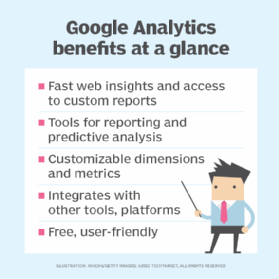
Fotolia
How can analytics improve content management?
Customer data and behavior analytics tools can give content managers insight into the kind of content site visitors want.
Content management isn't easy, especially when building a valuable web property.
Content teams might feel daunted by a wide range and high volume of content, especially in an age of increasingly dynamic customer-facing applications. But content management analytics and search engine optimization (SEO), especially when augmented with AI insights, can help teams better understand their audiences and develop a successful content strategy, which increases the value of the organization's content management investment.
Explore 10 ways that content management analytics can improve organizations' content strategies.
1. Tracks website traffic
Tools like Google Analytics can track website traffic. Commonly, a small percentage of a site's pages pull in most of the site's traffic, and Google Analytics can help content teams track website traffic and determine what content is effective. These analytics reveal how much time viewers spend on a page, which helps teams understand whether the content engages users.
Google Analytics can identify keywords that drive people to a page and determine which websites or pages they came from. This insight can help teams assess the effectiveness of their social media strategy. The tool also offers more nuanced reports that teams can customize based on their needs.
In recent years, vendors have developed several analytics tools that use AI. These go beyond website traffic analytics into customer sentiment analysis, predictive insights, complex data analysis and actionable insights.
2. Understands audience behavior
Analytics tools can measure bounce rate -- the percentage of viewers who leave the site after viewing a single page -- which can indicate whether a page engages users.

Tools like Google Analytics can measure visitors' geographic footprints to illustrate how well the site performs with intended markets and suggest potential additional markets based on organic uptake. Geographic, browser and platform metrics can help content managers target new markets and platforms -- like mobile vs. desktop -- to pursue.
Another tool, Amplitude, focuses on product analytics and uses AI to help businesses understand user engagement and retention. Its AI-driven insights aim to help products adapt based on user interactions.
Some tools offer behavior flow as a metric, which tracks visitors' viewing patterns and suggests their search intent. These sources can indicate what types of advertising and content marketing work best, compared to organic page views.
If content teams evaluate viewing patterns, they can optimize their content marketing plans and build or refresh their content strategy. When teams know why people visit a site, they better understand the best and most engaging content to develop.
3. Understands when to update or reorganize content
Some analytics tools can integrate web analytics and a content management system (CMS) to automatically elevate or reposition popular content within a site. News websites frequently employ this strategy, so the more hits an article gets, the higher it appears on the homepage. Content teams can boost this content manually based on analytics data before automating the process, as AI tools can also boost content. Yet, as with all AI, human experts should monitor the results.
4. Enables predictive content
Content management analytics can also enable predictive content, which uses customer data to determine how customers might receive or react to new content. This functionality generally requires a customized implementation and high interoperability between the analytics tool and the CMS.
Predictive content tools aggregate all site traffic data over time and apply machine learning to it. While content teams must look at specific patterns within site traffic data, they can also examine overall trends in site usage. For example, an analytics tool can demonstrate subtle changes in viewer behavior and reveal trends in customer interests and their causes. AI offers more nuanced predictions.
Content managers can use web analytics, SEO and predictive content to find useful insights and gauge and respond to dynamic viewer interests. These techniques can help create a data-based content strategy to produce appropriate content and ensure maximum viewer interest and engagement.
5. Improves business outcomes
Content analytics, especially when built on AI, offer actionable insights into content performance. They can analyze user behavior, engagement trends and conversion data, which can help businesses refine content strategies to align with audience preferences. This optimization leads to increased user engagement, higher conversion rates and improved customer satisfaction.
AI also enables more personalized content tailored to customer needs, which can improve brand loyalty and revenue generation. To the extent that systems understand customers, teams can tie personalization to CRM systems to improve long-term customer relationships and targeting. AI-driven workflows automate content approvals, publishing schedules and distribution across multiple platforms, which can reduce bottlenecks and increase efficiency.
6. Measures ROI
One key challenge in content management is accurately measuring ROI. AI-driven analytics tools integrate data from multiple channels to build a comprehensive view of content effectiveness. These tools assess KPIs, such as engagement rates, lead generation and conversion metrics, to determine the financial effect of content strategies.
Additionally, predictive analytics can forecast future content performance, so businesses can allocate resources effectively and maximize ROI. Automated workflows help track content from creation to performance analysis, ensuring every piece contributes to business objectives and improves ROI measurement.
7. Identifies gaps in content
Content analysis tools assess search queries, engagement patterns and content performance to identify gaps in existing content. AI natural language processing can detect topics audiences are interested in, but brands haven't adequately covered. If content teams recognize these gaps, they can develop targeted content to meet customer demand, enhance search engine visibility and strengthen content authority in their industries.
8. Enhances content creation efficiency
When teams understand how customers interact with their content, they can focus on areas of customer interest. AI-powered tools, such as natural language generation platforms and AI-driven SEO tools, can automate some aspects of content creation.
For example, AI can generate topic ideas or help write in real time. It can also analyze existing content for readability, tone and structure, and offer suggestions to improve clarity and engagement. This reduces manual effort, speeds up content production and ensures consistency.
AI can plug APIs into the CMS to access and process existing content and apply those APIs to content templates. Additionally, AI-powered asset management systems quickly organize and retrieve content assets -- such as images, videos and documents -- which reduces redundant processes and improves productivity.
9. Offers advanced audience insights
Understanding audience behavior helps teams create effective content strategies. AI-driven analytics platforms track user interactions across multiple channels to gain actionable insights into audience demographics, preferences and behaviors. Sentiment analysis and behavioral segmentation help businesses tailor content to different audience segments and improve engagement and satisfaction. AI also enables real-time monitoring of audience trends, so organizations can adjust their content strategies dynamically to remain relevant and competitive.
10. Enables real-time performance monitoring
AI-powered dashboards offer live analytics for performance monitoring -- including engagement, traffic and conversion rates -- so content managers can make immediate adjustments. Machine learning algorithms can detect anomalies, such as sudden drops in engagement or spikes in user activity, so content teams can quickly respond to emerging trends. With real-time data, businesses can optimize their strategies on the fly to remain effective and relevant.
Editor's note: This article was originally published in April 2019 by Scott Robinson and expanded by Jordan Jones.





